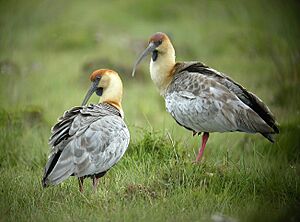Black-faced ibis facts for kids
Quick facts for kids Black-faced ibis |
|
|---|---|
 |
|
| Conservation status | |
| Scientific classification | |
 |
|
| Nonbreeding Yearound Breeding | |
| Synonyms | |
|
The black-faced ibis (Theristicus melanopis) is a cool bird that belongs to the ibis family. You can find it living in grasslands and fields in southern and western South America. It's known for its unique look, especially the black feathers on its face.
Contents
What is a Black-faced Ibis?
This bird is part of a group called Threskiornithidae, which includes ibises and spoonbills. The black-faced ibis was once thought to be a type of buff-necked ibis. However, most bird experts now agree that it is its own separate species. Some experts also consider the Andean ibis to be a subspecies of the black-faced ibis.
Naming the Black-faced Ibis
The black-faced ibis was first officially described in 1789. A German scientist named Johann Friedrich Gmelin gave it its scientific name. He called it Tantalus melanopsis at first. Later, it was moved to the genus Theristicus by another German scientist, Johann Georg Wagler, in 1832.
The name Theristicus comes from an ancient Greek word. It means "of reaping," which might refer to how the bird uses its long, curved beak. The second part of its scientific name, melanopis, also comes from Greek. Melas means "black" and -ōpis means "faced." So, its name perfectly describes its "black face"! This bird is considered a single species, meaning it doesn't have different subspecies.
What Does It Look Like?
The black-faced ibis is about 75 centimetres (30 in) long. That's about the length of a typical school ruler! It has a mix of colors that help it blend in with its surroundings.
- Its head, neck, and lower chest are a light brownish color, like buff.
- The top of its head and the back of its neck are a cinnamon color.
- Its upper body and a band across its chest are grey.
- Its belly and flight feathers (the long feathers on its wings) are black.
- The feathers covering its wings are whitish, but they don't stand out too much from the grey.
- Its bill, the skin around its eyes, and a small flap of skin on its throat are blackish.
- Its legs are a bright red color.
The buff-necked ibis looks similar but has some key differences. The buff-necked ibis usually lives in warmer places. It has large white patches on its wings that stand out a lot. Its lower chest is dark grey, not buff. Also, the flap of skin on its throat is smaller than the black-faced ibis's.
Where Do Black-faced Ibises Live?
You can mostly find the black-faced ibis in southern South America. They live throughout most of southern and central Argentina and Chile. They can be found from sea-level all the way up to about 2,500 metres (8,200 ft) high in the mountains. They also live in a very small area along the coast of Peru.
While they are still quite common in Argentina and Chile, they have almost disappeared from Peru. This means they have been wiped out from most of their original range in Peru.
Is the Black-faced Ibis in Danger?
Luckily, the black-faced ibis is not considered a threatened species overall. The IUCN (International Union for Conservation of Nature) lists it as a species of "Least Concern." This means there are still plenty of them around, and they are not at high risk of disappearing.


